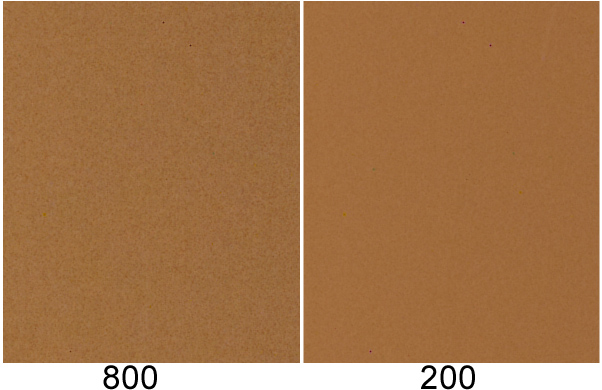 |
Deep Sky Polluted By City Lights Left: f/16 @ 800 ISO; right: f/8 @ 200 ISO equivalency, NEF format |
| Nikon D70 Digital Camera Reviewed | |
| by Bjørn Rørslett | |
5.
Long Exposures
In my review of Nikon D2H, I found this professional DSLR to feature the best long-exposure capability of any DSLR known to me. The tiny Nikon D70 cannot, by any stretch of imagination, hold a candle to the superb performance of D2H as far as noise-free long exposures are concerned. However, with a more appropriate reference. D70 holds its own well against models such as D100, and is definitively much better than the earlier D1-series in terms of low noise levels.
The test images presented below are small crops from 3-minute shots of a night sky (severely polluted by urban lights as it were). D70 was set up with noise reduction on. I matched the crops on a pixel-by-pixel basis by using "hot" pixels as control points. No sharpening was applied to the images.
 |
Deep Sky Polluted By City Lights Left: f/16 @ 800 ISO; right: f/8 @ 200 ISO equivalency, NEF format |
Several important features are apparent from these test shots. Firstly, the noise reduction program on D70 doesn't attain the high level of D2H, thus some "hot" pixels are present even in the processed image. Secondly, the increased native noise associated with a higher ISO equivalency tends to mask the "hot" pixels to a large extent, so despite the more prevailing graininess of the 800 "ISO" image, it in fact appears cleaner than the 200 "ISO" shot.
The user's manual for D70 advises against exposures longer than 1 sec, warning that coloured "speckles" may appear and mar the image. This advice is truly a precautious measure, so do try to expand your horizons by using much longer exposures. The D70 has a "B" ("bulb") setting, but this isn't very useful on its own because the camera lacks a traditional cable release. However, there is a nifty small accessory, the IR Remote Control ML-L3, which extends "B" to become a traditional "T" ("Time") setting. This means you open the shutter by pressing a release button on the ML-L3, go inside to enjoy some hot beverage or what have you, and then at the proper moment close the shutter by another click with the remote control. Again, the user's manual states there is a 30 minutes limit in effect here, but I haven't yet had the patience, or sufficiently dark night skies, to test this out. (A second perusal of the Mnaual indicates that 30 minutes indeed is a fixed upper limit).